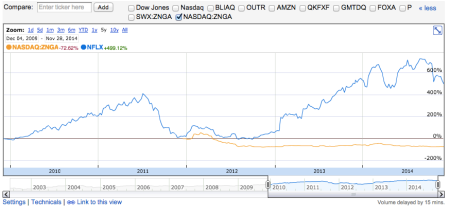There is a common myth that for super large scale companies it makes sense to build their own data center instead of using a public cloud.
In many cases I believe this is exactly the opposite. For many companies, time to market, focus and top line are more critical than a theoretical saving 20% on the cost.

The Killing , Wikipedia
Consider Netflix and Zynga. Both companies are large and smart enough to build their own private clouds.
Zynga chose to leave AWS and build their own cloud infrastructure. Netflix chose to stay on AWS, probably with a huge discount.
Their stock price might hint on which company made the right choice.
Netflix focused the company’s energy on moving from a tech company into a movie production studio with shows like “House of Cards” , “Arrested Development”,”The Killing” and “Orange is the new Black”. Zynga was busy in becoming a data center company. Instead of focusing on social games and preparing for the next big change into Mobile.
The more generic point is that the bottleneck in most companies is a person. More specifically, it is management attention. If everyone is busy in building a private cloud and purchasing 1000’s of servers, no one has time to create a new business line.
The thought is that a private cloud becomes attractive with huge scale because the number of devops people to write software has an upper bound.
This might be true, but there are very few people in the world who have already done it, and hiring takes a lot of time.
The other option is to hire inexperienced people, at least on this scale, and they would make mistakes.
Companies like Netflix and Zynga are supposed to have 70-90% gross margin. Reducing cost of hardware from 20% to 15% is nice, but even that is not straight forward. And in any case, it is much less important than losing or creating a new $1B on the revenue side.











